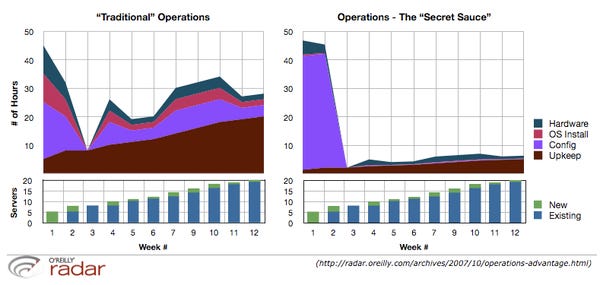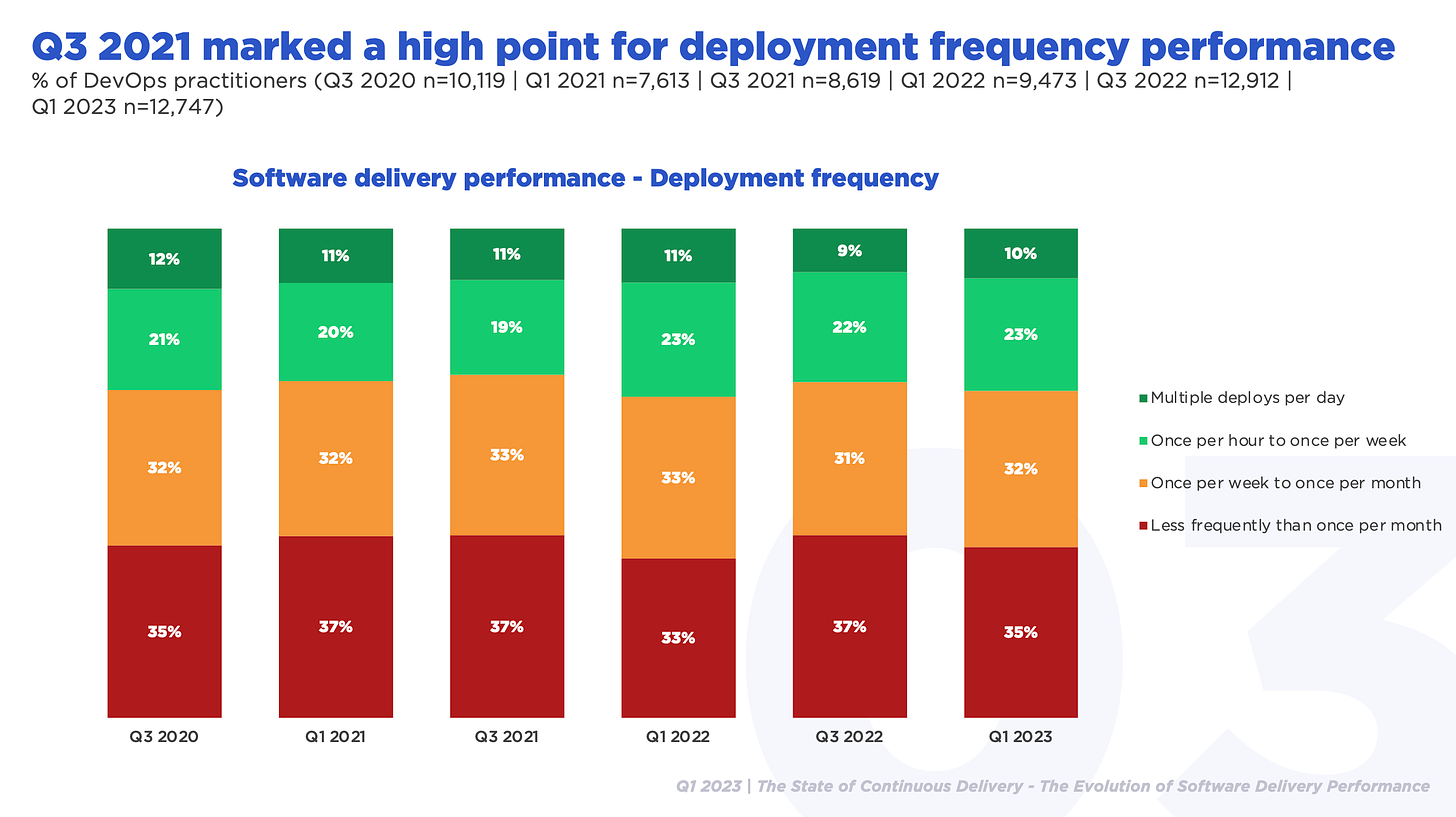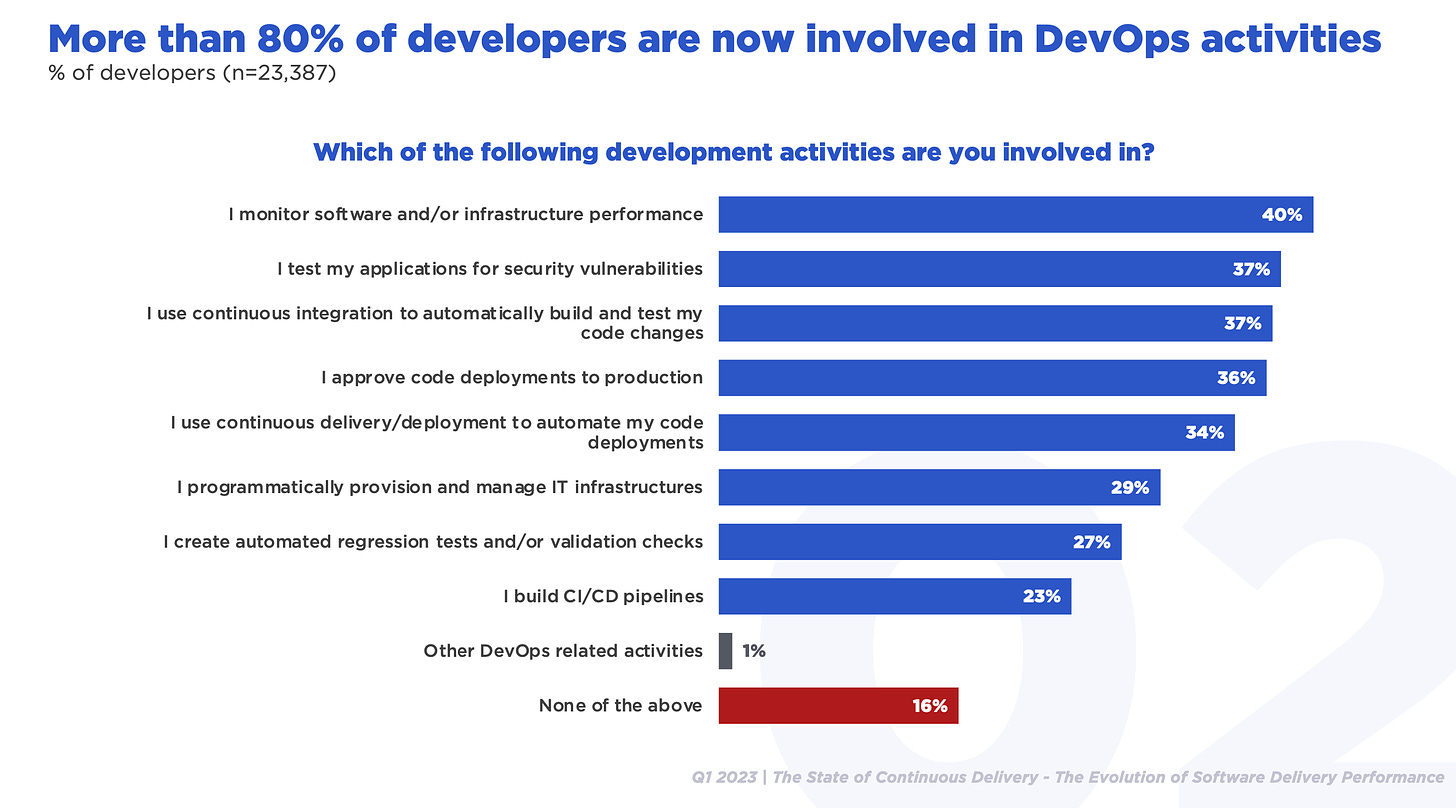Coté
28 Questions to Ask Your Boss in Your One-on-Ones - Good things to talk about in your meetings if you can’t think of anything else.
A modern-era lift and shift: Danske Bank seeks massive cost-to-income ratio improvement with the help of Infosys - As ever with outsourcing: hire cheaper labor under less restrictive labor laws…?
Software as strategy
I really liked how this first talk in out three part series came out. I wanted to talk as much as possible about actually strategy, business-think, so to speak, when it comes to how financial enterprises do software. All of us cloud native people spend a lot of time talking about the general benefits of cloud native stuff: better developer productivity and getting closer to the agile, deliver once a week (or daily!) dream; resilience/uptime; security blah blah; and etc.
These are good business outcomes/value, but I like getting deeper into what the actual apps are doing and how they’re helping create new types of business, products, and so forth. So, here, it was fun working with Darran (who’s actually worked on all this stuff at banks, most recently UBS) to talk about all that. Plus, I got to learn a couple new case studies from out customer base.
Anyhow, you should check it out. Sure, it’s a webinar, so you have to sign up for it, but: come on, no problem, right? You’ll enjoy it. Tell me what you think.
There’s two more in the series as well, next Tuesday and then Tuesday the week after that.
Changes in the streams
This week’s Tanzu Talk podcast: Ben and Ed try to help Coté understand what the changes in RHEL open source development mean. We don't figure it out completely, but get close enough. Also, Ed tells us what Crossplane is. Finally, we briefly discuss two new reports from Gartner and Forrester that seek to define the cloud native application stack.
Lost Videos
I found two videos I made that I’d forgotten about:
Depending on how you count them (are live streams of podcast recordings included?) I’ve made around 200 videos for work in the past three years. I started with some little goofy ones I made during paternity leave, then a lot more during COVID, and now it’s just a normal thing.
It’s not easy to make videos all on your own - it’s a multi-tool skill. Plus, you have to act, figure out the content, and promote them. The secret is that I was thrown into video making back in 2007 when I was at RedMonk. Or maybe it was 2008. Who knows. CIRCA &co.
We had a totally ridiculous (in a good way) contract with some early internet video startup whose name I forget. I think most of those videos are lost. Our boss was Steve Gillmor! His early podcast, The Gillmor Gang, was a huge inspiration for my own podcasting, general tech world thought leadership craft, along with Jon Udell, both who had shows on IT Conversations.
That didn’t last long (it was, after all, ridiculous). But, it lead to RedMonk starting up a video business, which I ran soup to nuts (except for sales, that was shared among the three of us). You can see those videos still in YouTube. As you’d expect 12 years later, their videos are insanely better now-a-days, not just a dork with a tripod in an poorly Las Vegas conference room and hallways.
Anyhow. I like making videos.
I’ve more or less come to accept that I both can’t and don’t want to put in the effort to get “famous” in the video world, which has sort of lessened me making videos more frequently. When you see that you only get, like, 150 views with only about 5 people watching all of the video, you start to think: why am I doing this? That’s in YouTube: the numbers in LinkedIn and Twitter are higher…but the people who drop off early on seem the same. I envy people who code in their videos: they at least are doing something instructional and there seems to be no end of content for them. I have to just talk in mine, and I’ve kind of said all I know to say.
Of course, there’s all the non-tech videos I make too, which are definitely worth it just for the fun:
I was thinking of all of this when I noticed I almost have 200 subscribers on my YouTube channel. Things are gonna start changing once I get over that hump!!
Upcoming
Talks I’ll be giving, things I’ll be doing, places I’ll be going.
July 4th, July 11th Cloud Native for Financial Services talk series. August 21st to 24thSpringOne & VMware Explore US, in Las Vegas. Sep 6th to 7th DevOpsDays Des Moines, speaking. Sep 13th, stackconf, Berlin. Sep 18th to 19th SHIFT in Zadar. Oct 3rdEnterprise DevOps Techron, Utrecht.
Logoff
It’s almost July! My mother is coming for the summer which is always great. The kids, of course, love seeing her; she loves seeing the kids; Kim and I like seeing here; and, I won’t be coy: we finally get some free time from the kids!
I’ll probably roll up the links next episode.
Lessons learned from Cloud Foundry for the platform engineering community
Here’s my talk from Cloud Foundry Day, last week:
The Cloud Foundry community has been around for a long time and the PaaSes built on it have been in use for awhile as well (many for at least five year, some for well over 7 years). In this talk, I first wanted to go over some advice on growing and sustaining a community build around a platform. And, second, I wanted an excuse to point out that Cloud Foundry works well for people and, you know, it’s kind of weird that we’re, once again, table flipping it all and starting over. But, you know: seems like what the overall cloud native community wants to do - good luck storming the castle meme, and all that.
Check out my co-worker Nick’s talk for proof of Cloud Foundry’s coolness, which he gave right before mind.
Wastebook
“I’m about to do a purge and burn on my RSS reader’s feeds, because it’s boring the shit out of me.” Here.
Real Kafka experience checking in at the hotel tonight(Frankfurt Airport Sheraton). Except the guests checking in were the maze and the clerks were the bewildered protagonists.
“While you study the cloud, he studied the blade.” Here.

Relative to your interests
Apple’s Vision Pro Is A Pricey Cabled Halo XR Headset For Developers And Prosumers Coming Next Year - Thorough industry analyst style review: “The target market for such an expensive device is developers, prosumers and enterprises that aren’t bothered by the external battery and wire. I genuinely believe that Apple’s customer base will be within the enterprise productivity space, many of whom are likely also prosumers.” And: “I wouldn’t bet against Apple, but I also think that the company hasn’t quite nailed down the new use cases for it yet, and that’s why I think this device is mainly trying to capture the mindshare of developers.”
It’s time for the Kubernetes value line - “There’s a reason the saying ‘culture eats tech for breakfast’ has become a favorite in today’s IT lexicon. What this pithy saying doesn’t get into is that technology can change behavior over time.”
Inside the Fantastic Smoked-Meats World of Lockhart’s New Vibrant Barbecue Restaurant Barbs B Q - “The menu is full of South Texas influences from Charnichart and Tovías’s Brownsville upbringings: the brisket is coated in Mexican spices, the ribs are tangy with lime zest, and in addition to the charro bean sides and concha pudding dessert, they’ve also added a twist on the usual mac and cheese by offering green spaghetti, a creamy poblano-based pasta.”
not for me - The anti-take take: “the value of responding to a book (or a movie, or TV show, or whatever) simply by saying: It wasn’t for me”
The Harried Leisure Class - This seems like a good way of thinking, but I can’t figure it out.
‘It’s every woman, it’s us’: Rotterdam falls for British statue of ordinary black woman - "It doesn’t stand on a plinth and isn’t an exalted representation of someone exotic. It’s just yourself, how you are, not a ‘super’ version. And how many images of black women are there?” And: “It’s every woman, it’s us – and it’s just standing on the floor like you and me.”
Backstage Disneyland - Amazing!
Smilemakers: McDonald’s approved vendor for branded merchandise - Imagine being so proud to be associated with a brand that you bought throw-back t-shirts and hoodies to wear on the weekends. It sounds like a good mindset to be in:
Lotte Hotel Little Secret - “Those three little stickers represent a beautiful universal guarantee: if you build a weird funky little hidey space, kids will find it.”
I don’t enjoy these 7 software development activities. Thanks to generative AI, I might not have to do them anymore - The blog title is accurate.
Working Remotely with Belkin’s BoostCharge Pro - Looks real nice.
10,000 microwave enthusiasts to attend annual microwave conference in Las Vegas - “Despite all this potential, my naive guess is that this conference doesn’t exist because nobody cares about what big microwave builds next. As useful as the appliance is, there isn’t much else for it to do.” // The joke here makes a good point about how technology strategy changes as it the technology becomes wide-spread and normal.

Upcoming
Talks I’ll be giving, things I’ll be doing, places I’ll be going.
July 4th, July 11th Cloud Native for Financial Services talk series. August 21st to 24th SpringOne & VMware Explore US, in Las Vegas. Sep 6th to 7th DevOpsDays Des Moines, speaking. Sep 13th, stackconf, Berlin. Sep 18th to 19th SHIFT in Zadar. Oct 3rd Enterprise DevOps Techron, Utrecht.
Logoff
We did our first talk in a three part financial services series today, this one on the topic of integrating software into your strategy. It was fun! I wanted to try out the “big pictures, no words” approach to slides.
Normally, I loath that kind of talk (both watching it and giving it). It worked out fine. Part of the motivation was that I wanted to have more back and forth, be more like a podcast. So, as I learned from Bridget a long time ago: if you have slides with big pictures, you can change what you talk about to whatever you want. Check it out: it also has some good content linking together business strategy and agile/design-drive software thinking. There’s two more talks, you should register for them and attend.
Also, I keep liking are.na. It’s fun to post there and fun to browse. Most of what I see there is clearly from designers and “creatives” rather than, like, fandom and collectors as seen at Tumblr. Which is fine: there’s already a Tumblr.
How's DevOps been going?
Has DevOps reached its goals from way back in the late 2000’s: deploying multiple times a day and having developers work closely with operations people? Adam Jacob brought up this question in two interviews recently, on my podcast, interviewed on my podcast by Matt Ray this week (which I [cough] haven’t, well actually listened to yet - maybe on the dog walk after I finish up here], and the Cloudcast, interviewed by Brian Gracely (I listened to that one real-good-like!).
Conclusions
After looking at it, my answer and analysis is:
Deployment frequencies (if I remember how they were in the 2000s) got much better, but have long stalled out at, I’d estimate, 50% deploying monthly or less. Not much progress has been made there for several years. But, if we readjust the goal from “multiple” times a day to “a month or less,” things have gone pretty good.
Application developers working closely with operations is not clear. Perhaps it wasn’t exactly the idea in the first place, and has been replaced by having a good platform in place for application developers. (We just need to finally focus on building that platform instead of re-starting it every five or so years.)
Without finding a bunch of charts to back this up, the job and culture of operations seems to be a lot better.
Now, let’s take a look at some charts to see how I got there!
(Oh, but first…)
OO Config & Release Management
First, how about the new idea Adam is showing up for?
I saw Adam reveal his new company back at cfgmgmtcamp. Their approach to configuration management looks nice: it’s like going whole-hog on object oriented programming for configuration and release management.
I mean, any configuration and release management ultimately rests on the actual code that updates the configuration: from fancy Kubernetes reconciliation, calling APIs on infrastructure, down to brute forcing it with automating SSH calls to modify weird Linux files. It is very gritty, tedious, and grueling that’s hidden behind clean abstraction layers (blah, blah) at the top. We’ll see how that work goes!
This new approach looks like fun, so hopefully we’ll see more of it.
Back to the idea that DevOps hasn’t met it’s goals.
Spock and Scotty Working Together
How would you rate the spread of DevOps? There’s a few metric-able things: Adam talks about developers and operations people working closely together on a release. I’m not even going to pour through my decade plus of saved PDFs to find a year/year survey question about that. It’s have to be something like “are operations people embedded on application development teams?” I’ll just add my anecdotes from talking with regular enterprises (read: not tech companies, large 5,000 to 10,000+ employee organizations) over the past ten years: no. (There’s a bonus chart below that sort of backs this up.)
Further, when you look at the talk around “platforms” for the past seven or so years (currently going under the phrase “platform engineering”), the whole space is pretty clear about keeping operations people separate from developers. The point of a platform, after all, is to automate as much of operations (esp. configuration and release management, but also just figuring out how to integrate everything together) as possible so that developers can focus on their applications - “moving pixels on the screen” as I like to say. I mean: this is great! YES, more of that.
Over the years, and once again, Andrew Shafer and friends have been reminding us that Warner Vogels mid 2000s decree that “you [application developers] build it, you run it” does not mean application developers run all of it down to the metal. It means that there’s a platform in place doing all of the hard work.
Deployment frequency, CI/CD

Deployment frequency is one of the major focuses of DevOps: how often can you deploy new code to production? Before culture emerged as - I don’t know, I’d say - the primary focus of DevOps, deployment frequency was a primary metric. This is the metric I’ve tracked over the years.
Deployment frequency the one I use to rate how well things are going when it comes to doing better at software. The more frequently you can deploy your applications, the more frequently you can learn what your users are doing, experiment with ways to do them better (by introducing new features in the apps and modifying existing ones), and get feedback about improvements. This is known.
The goal of DevOps early on was getting to daily deployments. Hmmm…“goal”: I don’t know, at the very least the aspiration and what seemed cool. However, over the years, and knowing the rates that large, not tech companies deploy, I think weekly to monthly is a fantastic goal.
I like to focus on “large, not tech companies” because tech companies are outliers to me. I care about what governments, banks, not-Amazon retailers, logistics companies, pharma…you know, the companies that fill our everyday lives when we’re not doom scrolling.
DORA - 81% deploy monthly or less, but the charts are weird & tech companies are over-represented
First, let’s look at the holy PDF, the DORA report. (Side-note: did we ever get the story of why the DORA reports forked from Puppet? It’s been long enough now that surely the tale can be revealed!)
There isn’t a chart that explicitly shows the percentage breakout of deploy frequencies, but you can make one if use the four clusters they have, which are created by various levels of the DORA metrics, including deployment frequency.
Here’s the chart of the percent of respondents in the four categories over the past four years:
I rebuilt the chart to a 100% stacked bar chart focused on deployment frequency (yes, one of them adds up to 107%: ¯\_(ツ)_/¯):
First, the span of “weekly to month” is kind of annoying. I’d want to see multiple times a day, daily, weekly, monthly, six months, an annually.
Second, things are weird in 2022 because they threw out the elite category (green above) because:
we don’t consider any cluster to be elite this year. This year’s high cluster is a blend of last year’s high and elite clusters. We decided to omit an elite cluster because the highest performing cluster simply isn’t indicating enough of the characteristics of last year’s elite cluster.
These numbers go back and forth so much over these four years that I’m not sure what to make of them.
The 2022 results are pretty bonkers: the report authors say the pandemic might have caused the huge shift to weekly to monthly Going from 28% to 69% is super-bonkers. You could look at just 2018 to 2021, but then 2019 is the whacky year too. Or you could look at changes in “elite” (deploying multiple times a day), but then since there weren’t enough elite performers in 2022, that 26% of respondents who deployed multiple times a day evaporated…?
I could look at shifts in demographics each year: were there big shifts each year? Like, were there more people reporting from large, not tech companies? From lagging geographies? From more conservative roles in the organization that might not have visibility into deployment frequencies (or the opposite)? But, I didn't!
So, let’s say that in 2022 11% of respondents can deploy daily or multiple times a day. By the goal of deploying multiple times a day, then, DevOps hasn’t had much success. However, again, getting large, not tech companies to deploy “weekly to monthly” things have been pretty fantastic.
But! By the goal of monthly or less, you’ve got 81%, which is clearly great.
However, since over 50% of DORA respondents are consistently from the tech world, I’m not sure. I’d want to throw out tech companies and just look at what’s left before concluding much.
(I looked at the 2017 to 2015 reports for these breakouts but couldn’t find them.)
State of Agile Reports - ~50% lack CI/CD capabilities
I’ve used the State of Agile reports over the years to track even the possibility of deploying frequently. These reports asked survey respondents if they used CI and CD tools. My theory is that if you don’t have CI and CD, you’re going to have a tough time deploying frequently. It’s certainly possible! …but not likely. We’ve all heard tales of people sftp’ing code changes to production, after all.
They stopped reporting on these metric in 2022. What I see in this chart is a steady growth in continuous delivery (the empty bars), but stalling out for continuous integration (the filled in bars).
Another way of reading this is that over the years, about 50% of people do not automate their builds (or maybe “pipelines”) because they don’t even have continuous integration.
I didn’t lookup the company demographics since I’d already made this chart sometime ago, and I’ve already spent a lot of time typing all this up. I’ve got webinars I’m supposed to be making slides for, friends.
By this metric, DevOps doesn’t seem to have done well at deployment frequency. At the very least, you’d want to automate the pipelines. I think?
CD Foundation - ~65% deploy monthly or less
Thankfully, the CD Foundation surveys have an easy to find, multi-year charts of deployment frequency:
So, here, we’re at about 30% for daily or multiple times a day. 35% for monthly or more, an equal amount for between a week and a month. So, let’s say, 65% can deploy monthly or less. That’s good.
What’s striking here is that it’s stabilized since late 2020, for the past 2 and half years (or whatever that calendar math is).
Without seeing the company size and industry break out, I can’t comment on large, not tech organizations. But, they throw in some commentary on large organization’s lead time (time from committing code to deploying, so a little different that deployment frequency [rolls eyes]):
Among developers at large enterprises (more than 1,000 employees [I’d call these medium-sized companies, but whatever -Coté]) we began to see an increase in top performers for lead time for code changes to 21% in Q1 2022, which has since decreased to 16%. However, despite the percentage of top performers decreasing, we still see that 40% of developers have lead time changes of less than one week, the second highest since we began asking developers.
So, 60% of developers at large enterprises have a lead time of a week or more. If we assume the week to month is similar to deployment frequency (like, 30%), then we have 30% doing a month or more. I don’t know, I just made that up!
Here, DevOps things are pretty great, but not getting greater.
As a bonus, here’s a chart showing the types of activities developers say they’re involved in
This is interesting when thinking of the “are the Devs working with the Ops…or at least, doing the whole ‘you build it, you run it’ thing?” Some are, but, sort of, less than 50% are doing many of the activities I’d call “DevOps.”
Forrester - 27% to 42% deploy monthly or less
Here’s two charts from Forrester:
First, it’s a little jarring when the legend and the chart are in opposite order, but, hey, maybe The Book was out of print at the time.
In this chart, 25% of people release monthly, while 50% are between a month and a quarter. 12% release weekly, and 6% release 1 to n times a day. Here, we have 42% (in 2021) of people releasing monthly or less.
In 2022 they changed the way they ask the question to: “How often does your team release through automation large or entirely new applications?” resulting in this:

So…let’s say 86% release their software a month or more: 15% average monthly, 31% average it every quarter, 26% twice a year, and 13% a year or more. And: 27% a month or less.
Forrester also asked for average/common release frequencies:

In the above chart, you get 26% of respondents saying they average a month or less to deploy.
So…27% to 42% of respondents deploy a month or less. Not too hot for DevOps.
Things are OK, but not super-fantastic
I don’t know, let’s say: “this Liberal Arts major concludes that something like 50% of organizations deploy monthly or less. [throws smoke bomb, and disappears!]”
13 years after the Spock and Scotty talk, things are probably better than they were back then. The only chart I have that goes back that far is the State of Agile one, which has shown tiny improvement since then.
I think the focus of DevOps has changed over the years and is less about deployment frequency and more about, I don’t know, making sure your software actually works in production - resilience? Also, as Adam comments on somewhere, DevOps has also made the culture of IT much better. We didn’t used to talk about, like, operations people being happy.
Putting the charts away and going back into the land of anecdotes, there’s a lot of work to be done when it comes to improving deployment frequency and over all improving how software is done. Again, things have improved, but not, like, for 100% of organizations, developers, and so forth. Or probably even 50% or 60%.
Also, it’s worth noting that we often forget how much has improved. I forget what bias it is, but a few years after a system improves, people reset their baseline for bad. You know: airline travel sucks, but we forget that traveling by horse is incalculably worse.
Reverting to yaml mean
As you probably recall, dear readers, my other theory is that we can’t help ourselves when it comes to maintaining focus on the application layer, “developers.”
Every five or so years we have to dive down the stack and mess with the infrastructure layer, halting our work on making things better for developers. That work is not only halted, it’s usually tossed aside. Most recently, we did this with Kubernetes. That layer itself is totally fine…great, even for what it does, standardizing infrastructure over cloud (native) stacks: an API and data structure; configuration, release, and operational models; and even application architecture.
But the overall ecosystem (vendors and end-users) got too obsessed with Kubernetes, despite plenty of pleading not to by the the Kubernetes sages. The dog that caught the bus, etc. And we’re still too obsessed. Hopefully, it’s lessoning as it dawns on everyone that getting better at software means paying attention to the application layer and developer productivity.
Something like 50% of surveyed organizations can deploy their apps monthly or less. That number is probably less for large, not tech companies. Even if that’s 40%, even 30%, that number is great compared to what it probably was back in 2009. Let’s keep up the work to get the rest of them fixed up.

Upcoming
Talks I’ll be giving, things I’ll be doing, places I’ll be going.
June 28th, July 4th, July 11th Cloud Native for Financial Services talk series.August 21st to 24th SpringOne & VMware Explore US, in Las Vegas. Sep 6th to 7th DevOpsDays Des Moines, speaking. Sep 18th to 19th SHIFT in Zadar.
Logoff
This DevOps question is a little unfair in that it can seem like it’s precise. I mean, it’s just some charts and trying to make sense of them. If we had all of the years of DORA charts with the deployment frequency and other characteristics over time, I think that’d be the best. Perhaps that exists! But I didn’t look long enough to find them. Tell me what you think, and see y’all next time.
It’s time for the Kubernetes value line - “There’s a reason the saying ‘culture eats tech for breakfast’ has become a favorite in today’s IT lexicon. What this pithy saying doesn’t get into is that technology can change behavior over time."














